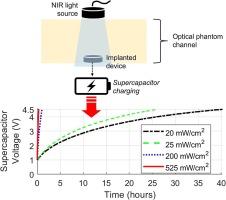Investigation of optical wireless power transmission across biological tissue using NIR light considering safe irradiance level
IF 3
Q3 Physics and Astronomy
引用次数: 0
Abstract
Presently, implantable electronic devices (IEDs) are becoming integral choices in medical applications, still their reliance on nonrechargeable batteries limits their longevity. This challenge has driven worldwide interest in developing rechargeable IEDs. While energy transfer based on radio-frequency (RF) has been clinically employed to address the challenge of IEDs running out of battery power, research into alternative methods, such as near-infrared (NIR) light-based energy transfer schemes, is advancing rapidly. The key advantages of optical systems are security, privacy, safety, interference-free operation, etc. The properties of NIR light are attractive for optical wireless power transmission (OWPT) across biological tissue due to minimal scattering and absorption effect. NIR light has been widely employed for various therapeutic applications, such as photobiomodulation (PBM) therapy. When using power transfer, ensuring that do not exceed safety regulations to avoid damage to the tissue is important. In this study, we investigate OWPT under safe level irradiance referring to the typical PBM applications, i.e., 20 mW/cm2, 25 mW/cm2, and 200 mW/cm2. The OWPT system is tested on an experimental testbed, consisting of an 810 nm NIR LED and a photovoltaic (PV) cell as transmitter and receiver, respectively. A tissue-mimicking optical phantom was employed as a propagation media that has long-lasting stability at a room temperature around the testbed, thus suitable for prolonged experiments. We measure the time it takes to charge an energy-storing supercapacitor under three different safe irradiance levels to assess the feasibility of safely charging an IED’s storage. In addition, we compare the results with the maximum irradiance of NIR LED, i.e., 527 mW/cm2. Comparing 527 mW/cm2 to PBM irradiance revealed a trade-off between supercapacitor charging time and tissue safety. Charging limitations and other related issues are also elaborated in this paper.

考虑安全辐照度的近红外光跨生物组织的无线光传输研究
目前,植入式电子设备(ied)正在成为医疗应用中不可或缺的选择,但它们对不可充电电池的依赖限制了它们的使用寿命。这一挑战引起了全世界对开发可充电ied的兴趣。虽然基于射频(RF)的能量转移已被临床应用于解决ied电池电量不足的挑战,但对替代方法的研究,如基于近红外(NIR)光的能量转移方案,正在迅速发展。光学系统的主要优点是安全、隐私、安全、无干扰等。近红外光具有极小的散射和吸收效应,可用于生物组织间的无线光传输。近红外光已广泛应用于各种治疗应用,如光生物调节(PBM)治疗。在使用电力传输时,确保不超过安全规定,以避免损伤组织是很重要的。在这项研究中,我们研究了在安全水平辐照下的OWPT,参考了典型的PBM应用,即20 mW/cm2, 25 mW/cm2和200 mW/cm2。采用810 nm近红外LED和光伏电池分别作为发射端和接收端,在实验台上对该系统进行了测试。采用组织模拟光学幻影作为传播介质,在试验台周围的室温下具有持久的稳定性,因此适合于长时间的实验。我们测量了在三种不同的安全辐照水平下为储能超级电容器充电所需的时间,以评估安全为简易爆炸装置的存储充电的可行性。此外,我们将结果与近红外LED的最大辐照度(527 mW/cm2)进行了比较。比较527 mW/cm2和PBM辐照度揭示了超级电容器充电时间和组织安全之间的权衡。本文还对充电限制等相关问题进行了阐述。
本文章由计算机程序翻译,如有差异,请以英文原文为准。
求助全文
约1分钟内获得全文
求助全文
来源期刊

Results in Optics
Physics and Astronomy-Atomic and Molecular Physics, and Optics
CiteScore
2.50
自引率
0.00%
发文量
115
审稿时长
71 days
 求助内容:
求助内容: 应助结果提醒方式:
应助结果提醒方式:


